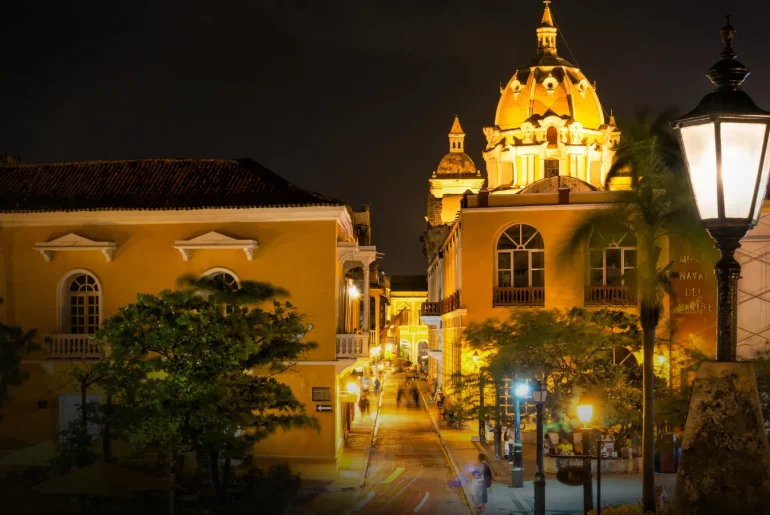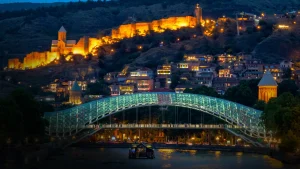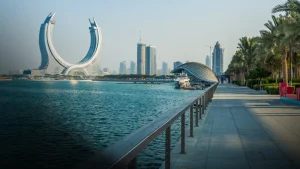We’re thrilled to continue our “Stories of Telecom Success” podcast series, where we delve into the dynamic world where technology, security, and business competitiveness intersect. In each episode, we bring you insights from leading experts who are shaping the future of these interconnected fields. Today focus on safer and more competitive businesses thanks to AI and video surveillance: the LATAM case

Today, we’re particularly excited to feature a distinguished guest who embodies the spirit of innovation and strategic leadership. We’re joined by our partner in LATAM Region Ricardo Calderón, as Global Chief Operations Manager at AiBT Global Group, bringing a wealth of experience from his career leading transformation projects, product development, and business strategy.
In this episode, we’ll be discussing the critical role of video surveillance and artificial intelligence in enhancing security, driving digital transformation, and boosting business competitiveness across Colombia and Latin America. Get ready for a profound, timely, and strategically relevant conversation that promises to offer valuable perspectives on the evolving landscape of these vital technologies.
Introducing
Dimitri: Welcome to a new episode of our podcast, where we explore the frontiers between technology, security, and business competitiveness in Latin America. I’m Dimitri, and today I’m joined by my colleague Alexander Carpenca. We both represent the VSaaS Aipix platform. How are you, Alexander?
Alexander: Very well, very well, delighted to meet all of you, and I’m really happy to be here.
Dimitri: And today we have the privilege of hosting a very high-level guest: Ricardo Calderón, an industrial engineer with a solid academic background. Ricardo holds an MBA from Universidad del Norte, a Master’s in International Business from Florida International University, and is currently pursuing a doctorate in Business Administration at King Juan Carlos University in Spain. He currently serves as Global Chief Operations Manager at AiBT Global Group. Throughout his career, he has accumulated extensive experience leading transformation projects, product development, and business strategy. Good morning, Ricardo, how are you?
Ricardo Calderón: Good morning, how are you all? Greetings from Colombia.
The LATAM’s Technological Sector Review
Dimitri: I’m very happy to have you with us. With this level of experience, today we’ll discuss the evaluation of video surveillance and artificial intelligence in Colombia and Latin America, and their key role in security, digital transformation, and business competitiveness in the region. Get ready for a deep, current, and strategically relevant conversation. Let’s begin. To better understand the global panorama, I’d like to know, Ricardo, which technological sectors are currently experiencing the fastest expansion in Colombia, and how do they compare with those in other Latin American countries in its surroundings?
Ricardo Calderón: Well, excellent question. Currently, in Colombia, there’s a great demand for electronic surveillance and electronic security services, especially in the service sector, represented by hotels, gastronomy, and bars. Similarly, the office sector, residential buildings, houses, and residential complexes are also seeing high demand. Why? Because, unfortunately, in Colombia, we’re having a big security problem. The rise of criminality has grown a lot. The topic of Smart Cities, the security of cities, departments, and territorial entities, also has a great demand, but we haven’t done absolutely anything. Why? Because we haven’t mapped our insecurity zones, so to speak. There isn’t enough police force, enough material, or enough people to cover the entire territory.
If we compare this situation with the rest of Latin America, I’ve always said we have small groups. For example, we have the Andean zone, what we call Colombia, Ecuador, Peru. Colombia, Ecuador, Peru, unfortunately, along with Venezuela, is a totally different country. Here we have serious problems in terms of security due to transnational criminal gangs. I don’t know if you’ve seen the news about the famous Tren de Aragua, which is a transnational gang involved in everything from drug trafficking to human trafficking. All the crimes you can imagine.
There’s also the Southern Cone, which includes Argentina, Chile, Paraguay, and Uruguay. They also face the same problems. They also face the Tren de Aragua, but they do have more developed and structured solutions for video surveillance, and also more budget, more money, because their economies are much stronger.
We have Brazil, the great giant of LATAM. It’s the seventh-largest economy in the world, according to the USD, and it has many security problems due to social inequality. If you look at the Gini index, which measures a country’s inequality, Brazil is among the worst, even though it’s the seventh-largest economy in the world.
Central America, except for Nicaragua, generally has very democratic governments. Again, they face security problems from criminal gangs, but they have developed somewhat more surveillance structures. Of these economies, the safest in terms of surveillance and also economically, because everything is directly related, are Costa Rica and El Salvador. Going from being the most dangerous country in Latin America to the safest. And that has brought a lot of economic investment to the country at this moment.
And then we have, obviously, Mexico, the number one commercial partner of the United States. Unfortunately, and fortunately for them economically, they share a border with the United States. But unfortunately, they have a big problem with the commercialization of fentanyl, which is imported from the United States. Unfortunately, the impetus for security has declined.
Finally, we have a small group: Venezuela, Bolivia, Nicaragua. So, that’s more or less the panorama of the entire region and Colombia with respect to security and video surveillance.
Columbia Security Situation
Alexander: Very good, thank you very much. Another question: despite all these difficulties facing the region, well, the entire Latin region, do you think video surveillance technology has evolved? In what aspect? And also, if it was thanks to that, what do you think?
Ricardo Calderón: Yes, absolutely, video surveillance has evolved impressively. Why? Because, thankfully, globalization has allowed economies to start interacting through international trade. And that has led international players, large companies, to establish themselves in these territories. This has forced video surveillance and private security to improve, to update, to stay updated. But these major developments are almost indisputably driven by private companies, by the private sector as a whole. The government sector, again, with some honorable exceptions, such as the government of Buenos Aires, which is a city with great video surveillance development due to the Smart City initiative. Unfortunately, these Latin governments, when they think about security, they think about increasing the number of police, increasing the number of men, buying more motorcycles, buying more vehicles. But they don’t yet see video surveillance as something that can be a strategic ally to improve the security of the regions.
Alexander: Right.
Ricardo Calderón: But we’ve improved a lot, though we still have a long way to go. And look, I’ll tell you something: regarding internet connectivity, we’re in the main cities. For example, here in Colombia. I can tell you that even though in the cities we have almost 100% coverage, the connectivity isn’t entirely good. And that’s despite having major players like Telefónica, Movistar, Claro, and the Millicom group through Tigo. So, there are still many barriers to overcome, you know? But Latin America is an excellent market. It’s a growing market where I think and believe that video surveillance, especially that based on AI, has an excellent, immense market.
AI and Video Surveillance in LATAM
Dimitri: You mentioned coverage in Latin America. Are there other specific regional challenges and opportunities that influence the growth of the video surveillance sector in Latin America?
Ricardo Calderón: Yes, of course, absolutely. Look, while it’s true that criminality. Well, let’s say large criminal groups have large budgets due to their illicit business revenues is the great opportunity we have is precisely to counteract them, and definitely video surveillance, especially those tools for facial recognition, the issue of, for example, lost objects, the ability to communicate, to interconnect all security cameras, man, that is, let’s say, the great opportunity in the world, okay? In Latin America, Latin America is growing, but everything is yet to be done.
We’ve done some things through the security multinationals themselves, like G4S, Prosegur, BRS, Securitas. Of course, these are large companies that have budget and bring technology. But the security companies themselves — and I’ll always talk about security companies because they’ve been a great driving force for video surveillance — are bringing in technology from outside precisely to be able to address all the challenges the region faces.
Dimitri: And speaking about cloud video surveillance technology in particular, is cloud surveillance popular in Colombia? How do you see its prospects for Colombian companies? And what are the main restrictions hindering the development of this technology?
Ricardo Calderón: Yes, well, honestly, it’s not that popular. Why? Because of the accessibility to the service. Only large multinational firms use this technology. They have the funds and staff. I worked at Telefónica Movistar for two years. We offered cloud security to big businesses. These services did not sell well. Money, knowledge, and preparation were often lacking. The biggest hurdle now is not money. It’s finding skilled workers. We need people to implement these solutions.
Common Drivers for Security Systems Development in Columbia
Alexander: And what are the most common uses of cloud video surveillance systems in Colombia? And also, if these solutions are adapted to face local challenges such as, for example, crime or urban congestion at a B2G level, how does that happen?
Ricardo Calderón: The main applications are, again, and the end customers who can acquire this type of solution use them for their own security, right? The large industries that are monitoring their entire environment to prevent any crime by criminal gangs. But let’s talk about reality, that is, apart from those small islands. I’m talking about Colombia. I’m talking about the vast majority of Latin American countries. And again, with honorable exceptions, Buenos Aires, São Paulo in the case of Brazil, Brasília, Curitiba itself, which is another city I have in mind, San José, Costa Rica, which do have a great development of video surveillance. There really aren’t facial recognition cameras, you know?
I’ll tell you an anecdote. I was in Bogotá, it’s incredible, Bogotá has about 12 million people right now, and there are only about, I don’t think there are more than 200 facial recognition cameras in our main capital.
Dimitri: 200?
Ricardo Calderón: 200! It’s incredible, there aren’t any, mind you, facial recognition cameras. There are cameras for speed control, mainly for that, right? But really, to combat crime, you see, it happens a lot with the police. For example, when a crime occurs, they have to resort to the security cameras of private companies, of bars, for example, if it happens on the street, right? Bars, restaurants, to be able to recreate the entire crime scene and see effectively what happened because our cities really lack that, and again, I’m telling you this is Latin America in general, with the exception of one honorable exception, okay? Which I already mentioned, they’ve already developed a great path. So the market is still virgin for exploitation.
AI and Video Surveillance in LATAM – New Era for Control
Dimitri: Excuse me. And in general, how do municipalities or public institutions use video surveillance to combat crime or improve urban management?
Ricardo Calderón: No, they don’t do it, look, I’ll be honest with you. Let’s talk about cities. The cameras cities have are for speed control, that’s it, nothing else, to prevent people from running red lights, that’s right. If we talk about rural areas, the situation is even worse. The problem is that again, we have a mental paradigm. We need to improve security. We’re going to increase the police force. To increase the number of police officers, we’re going to buy more motorcycles. We are going to buy more vehicles, but we don’t really implement, the topic of AI, video surveillance as a support for urban and rural security, we haven’t done it.
Dimitri: Well, it can be said that instead of opting for quality, they opt for quantity.
Ricardo Calderón: Yes, increasing, that’s right, again, it’s a topic, again, our mental paradigm is, more surveillance, we want to improve surveillance, we have to increase the police force, we have to increase the number of police officers, we have to increase the number of motorcycles, of vehicles. We still haven’t developed a strategy. Look, I’ll tell you, I was in a project to present a video surveillance solution to the city of Barranquilla. Barranquilla is the fourth city in Colombia. It’s the main city on the coast. We have two million people in our metropolitan area, and notice that when we were doing that preliminary project, we realized that and they gave us data from the police, from the SIJÍN, which is also a special police force that deals with security
Interpol, it’s incredible and we couldn’t use the data for anything. Why? Because it wasn’t useful, that is, there isn’t, let’s start with the most basic, making a characterization map of the insecure zones of the city. Obviously, I know which are the insecure zones of my city, but I would like to have the data to know at what time the crimes occur, what type of crimes are committed, we don’t have any of that. So, notice, where do we have to start, making a map, obtaining information, being clear about what security entities have, what type of security systems, what type of cameras, how they manage them, all of that is yet to be done.
Dimitri: Well, AI usually helps with this. And I would like to know, what is the current state of Artificial Intelligence implementation in video surveillance systems in Colombia and what factors limit its wider adoption.
Ricardo Calderón: Yes, yes, Dimitri, Alexander, let me tell you something, I’m ashamed, but I have to be honest, because AIBT is a factory of knowledge and AI. We, additionally, represent Artificial Intelligence companies. And I’ll be honest with you, we are in our infancy in Latin America in terms of the uses of AI in industrial matters, in production matters, in operational matters, in sales matters, in the matter of, in the matter of video surveillance, even worse. There are, look, at the level of senior executives in Latin America, again, because we’ve been able to talk, there is, let’s see, there is knowledge of AI, yes, everyone knows, because we are immersed in that world, but there is a lack of knowledge of what Artificial Intelligence can do for them.
So, when we talk about video surveillance, we still have, the poor security guard watching 10, 15 cameras, okay? 10, 15 TV screens. So, I tell them, how can a person not, how is a person going to be able to detect crime? How is a person going to be watching 15 cameras to see if it’s a crime? Impossible, that’s where the challenge of Artificial Intelligence lies, okay?
AI Limitations in Latin Region
Dimitri: But are there technical or legal obstacles or limitations, I don’t know, to integrate intelligence?
Ricardo Calderón: No, not legal ones, the limitations are of knowledge, that is, bringing the technology to be able to implement it, okay. There’s a, again, connectivity, it’s unfortunate to have to talk about this, but having, it’s incredible that having three large multinationals in the field of internet connectivity, we still have failures in the system’s supply and I’m talking about the city. In rural areas, the coverage perhaps doesn’t reach 70%, don’t you think?
And, let’s say the issue of costs, I always say something, for example, look, buildings, buildings, residential complexes, offices, big market, but we still have the security guard, okay? Why? Because we haven’t been able to find or there isn’t an offering of solutions in the market have a great cost-benefit relationship. I’m not going to say that they are economical, that they are cheap, but that they really have a high cost-benefit value for what I’m paying, that they give me a great benefit.
Simpler systems, facial recognition cameras to allow the entry of large volumes of people in companies, it really doesn’t work. I work in a 21-story building, I work on the floor and to be able to enter during peak hours, that is, entry hours, 8, between 7 to 8 in the morning, between 12 to 1 in the afternoon, between 5 to 6 in the afternoon, there’s a big, well, that’s a Colombian word, “trancón,” there’s a great difficulty for people and everyone, we all enter with the card because the facial recognition camera doesn’t allow us. Imagine, there are great difficulties, but there are huge opportunities in the store.
Dimitri: Right, well, you mentioned facial recognition and what do you think, what cases of video analytics based on Artificial Intelligence, of course, would interest people more, would interest managers more to, I don’t know, to make life better.
Ricardo Calderón: I just told you one: entry. The, the first, what I just told you, one: personnel entry.
Ricardo Calderón: Okay, being able to allow people to enter with a camera, through facial recognition, not entering with a card. I’m talking about large companies that have 1,000, 2,000 people working, the case of my building where I work, where we can be around 5,000 people, imagine.
The great restriction to be able to enter during peak hours is complicated. But in addition to that, in terms of productivity, for example, I see, I see great opportunities, for example, in industrial matters. For example, recognition cameras that allow monitoring where people are seeing, I’m going to remove the word monitoring, seeing where people are, if they are complying with industrial safety issues, environmental safety issues, also in the matter of crime, let’s say of security as such, well, the detection of, lost objects, that were left there or forgotten objects. Let’s say that if we can, look, I’m giving you three business opportunities, three, these opportunities can lead to endless business.
Okay, but there is one that these opportunities are already on the table, right? No, yes, Smart City, that is, offering cities a video surveillance system, facial recognition with Artificial Intelligence for crime reduction. Being able to do small pilots in the areas that we already know are the most dangerous. Oh, any. That would be a spectacular business, it would be an opportunity, a way to improve people’s lives, that is, there really are opportunities, aren’t there?
The Future of Video Surveillance Development in Columbia
Dimitri: Yes, totally agree. Well, Ricardo, you mentioned that Colombia is still in its infancy with AI, so why do you consider this technology in the video surveillance sector to be crucial for the development of security in Colombia in the future?
Ricardo Calderón: No, it’s not even in the future, I tell you in the present. Why? Because, well, again, just as businesses have become international, we have globalized it, delinquency has also globalized, okay? And delinquency has large budgets, great financing to be able to continue growing. Unfortunately, let’s see it as a parallel industry, as an industry, crime wants to keep growing, well, it will keep growing because it has a large budget. And that’s where the great opportunity comes: how to help authorities combat crime and also to keep us safe. So, obviously, there is a great impact there, for the development, not only of Colombia, in Latin America.
It’s that again I tell you, in Argentina there is only Buenos Aires, which is the capital, right? But in the rest of the other cities like Rosario, in Brazil, Brasilia, and Sao Paulo, Rio de Janeiro, still has a big problem. There is facial recognition camera, but it is not the quantity that there should be. And and again, well, the issue of AI seems so vital to me because where the human being is, there is error. So, if AI manages to, at least be verifying what is happening, to be able to understand that this person is committing a crime, instead of having the poor poor human being watching 20 security cameras, well, obviously we could have a great impact not only at the business level, but socially.
Dimitri: Clear, what they say today is that Artificial Intelligence does not serve to substitute the human being, but to go hand in hand with him, that’s what it’s for.
Ricardo Calderón: Clear, exactly, exactly of recognition. For example, I come from an industrial sector too, and well, for example, the food sector is totally industrialized, it is totally, let’s say, robotized, but nevertheless the human being is needed. You see the large food production plants of any soda, you see two, three people being attentive that the machinery is well. So, I have always said, why not have a camera with video surveillance with the topic of with the topic of Artificial Intelligence to be able to see if suddenly at some moment the production process stopped?
Dimitri: Clear, clear. Right now, how is this done? With sensors?
Ricardo Calderón: Clear, but behind. Okay. It is not totally independent, it has been automated, production systems have been improved, yes, but still the human being is totally vital. So, that’s where I say, why couldn’t AI help through a biosurveillance system to see what is happening to the machine? It would be spectacular.
The Significance of AI Innovations
Alexander Carpenca: Yes, Ricardo, and following the topic with of industry, what importance do you think it has for the industries of Latin America to adopt video surveillance systems based on Artificial Intelligence to continue being competitive?
Ricardo Calderón: It’s that let’s start with something, how do I make my economy grow? Okay. I need to have good economic conditions, that attract the investor, I need to have an operational structure, good communication system, good hotel system, in short, I need to have an ecosystem, but…
Ricardo Calderón: What are we missing? The ecosystem, security. So, if I am able to tell an investor “Come here, come to the Colombian economy, come to the Peruvian economy, we are giving you the conditions of financial type, of economic type, of operational type, of regulatory type”. And additionally, I am giving you the topic of security, man, well, vital! It’s that I look at the transformation of El Salvador. El Salvador was a country where nobody, none of us wanted to pass. I have gone down through Central America a lot and tried to avoid, in short, I avoided it, okay, I avoided it in every way, but now we all want to go to El Salvador because look at the transformation, the impulse that this new president gave it from being the worst country to the safest country.
What has happened with El Salvador? The large multinationals are going to establish themselves there because it was not only the topic of security, the topic of the economy, the topic of financing, the topic of operability, which is, notice what a single factor like the topic of security could do for an economy that was failed, for a failed country like El Salvador. So, we managed to establish that in all of Latin America and that happened in I don’t know, in about 5 or 7 years, right?
Dimitri: Very fast.
Ricardo Calderón: It’s just that, yes, yes, that’s very fast. What there was, was political will from a president to improve, to improve the security of El Salvador. Remember that from El Salvador comes the Mara Salvatrucha, which is one of the, of the, of the gangs, of the most dangerous gangs in the world and it is established in the United States and with networks throughout Latin America. So, imagine the challenge he had to go through. So, security is vital, that is, believe me that an investor or even someone who is setting up, us who are setting up companies, to say, man, where can we be, where do we feel safer? That’s an issue. It even impacts the emotional health of the person, the issue, obviously.
Dimitri: Ah, Ricardo, well, concluding our podcast, I would like to ask you, what do you think about how these technologies will influence the daily life of people in Latin America in the coming years? Your predictions.
Ricardo Calderón: My predictions are that, well, we are a global market. We, the economies are already globalized, despite the attempts of some presidents to keep to themselves. That is now impossible. Man, AI, technologies have to be part of Latin America for us to make that leap from emerging economies to developed economies, okay? That is vital. We have to have them and they will come. You know why I tell many businessmen: it’s that if you don’t apply AI today, you disappear tomorrow. And I can also say it as the topic of security: if we don’t manage through AI to improve our security, we can disappear as a society too and as an economy.
So, how do I see it in the years to come? It’s mandatory, we will have to use it. And it’s that, for example, this new generation, the generation of young people, from below, let’s say, from 25 downwards, already has the elements of artificial security, in all their life, right? In all their life.
Dimitri: Clear.
Ricardo Calderón: So, for Latin America it is a great challenge, but and that is something I love to say, thank God we have this challenge because it forces us. It’s that no, this is not something we want, it’s something we have to do now, now.
Dimitri: Well, totally agreed, Ricardo. Thank you for the shared information, it has been a true privilege to count on your participation. You are a professional with a comprehensive vision of the business ecosystem of Latin America and I believe you have helped us to understand in depth how video surveillance and Artificial Intelligence are not only redefining security, but are also positioning themselves as pillars for the competitive and sustainable development of the region. Surely. Thank you for joining us in this episode. Remember that you can follow us for more conversations with high-level experts who are leading the transformation in Latin America. Until next time. Thank you, Ricardo.
Ricardo Calderón: Thank you, Alejandro. Have a good day. Thank you.
Fortify The Enterprises with Aipix
This is precisely where Aipix serves as a key partner. For more information visit our YouTube-channel .
Aipix is more than a video surveillance system; it is a comprehensive, cloud-native platform designed to enhance how enterprises oversee, safeguard, and refine their operations. By integrating AI analytics within a cloud environment, Aipix transforms visual data into actionable intelligence. This includes capabilities such as real-time anomaly alerts and insights into operational efficiency – all accessible remotely. This approach is particularly relevant for the evolving landscape of AI and Video Surveillance LATAM, where businesses are increasingly seeking advanced, accessible solutions.
Discover how Aipix can deliver intelligent, cloud-powered surveillance solutions for your organization.
Contact us for detailed project!





